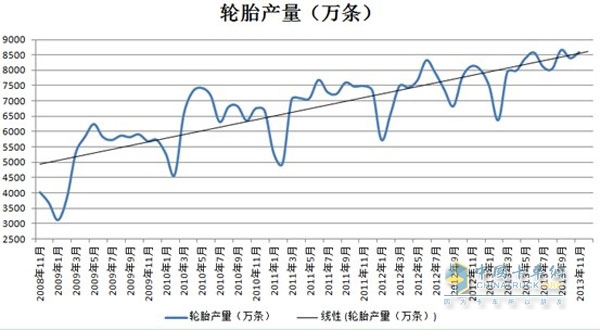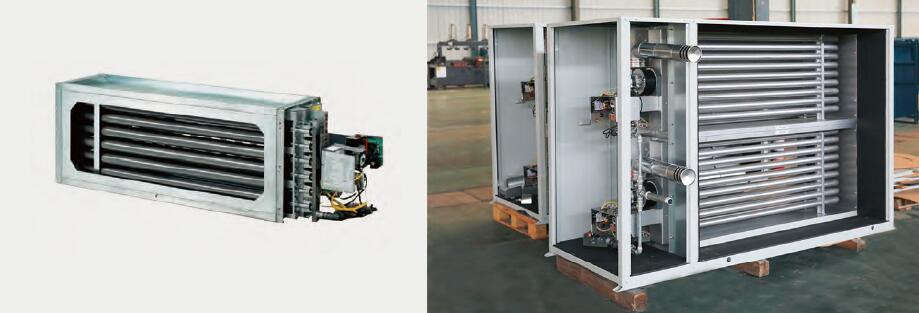Driven by the macro economy, China's tire industry has experienced rapid development in recent years. Domestic and foreign companies have increased their enthusiasm for investment, and production capacity and output have expanded significantly. By the end of 2013, the number of domestic tire companies had grown to a few hundred, and the overall capacity even appeared surplus. Faced with this situation, some people in the industry are concerned that the development period of the tire industry is over. Is the smooth period coming so soon?
Let's look at a chart first. The following figure shows the trend of changes in the output of the Chinese tire industry from 2008 to 2013. From this we can see intuitively the changes in the output of the tire industry during the five years.

First, to observe the curve in the chart, the intuitive feeling is that the overall output of the Chinese tire industry has grown steadily over the past five years, and the momentum of development in the industry is still good. For example, at the end of 2008, its overall output was still at a relatively low level, but after the Spring Festival in 2009, production has grown rapidly, and monthly production has even approached 60 million, and it has remained relatively stable for a period of time.
Through the rapid development in recent years, by the end of 2013, the monthly output of China's tire industry has reached 85 million, which is three times the monthly output in late 2008. In just five years, such achievements have shown that the Chinese tire industry has indeed developed rapidly. At the same time, it has also led to the progress of related industries and has played an invaluable role in promoting the employment of the labor force and local economic development.
Second, there is a clear trend in the cyclical changes in China's tire industry. As can be seen from the figure, during the Spring Festival period, due to the decline in the operating rate of production companies during the holiday season, their production data will drop by a certain extent, and will rise again after the Spring Festival. The cyclical changes will be very obvious.
Thirdly, through the horizontal comparison of the curves in the chart, it can be found that the overall output growth rate of China's tire industry has slowed down in the past five years, especially after the rapid development period of 2009-2010, the growth rate of tire production has declined. The fluctuations in output have slowed down and have stabilized.
To sum up, from a macro perspective, the overall development of the tire industry is good, with rapid production growth, and the overall development of the industry tends to be rational. Although the issue of cyclical changes in output still exists, the fluctuation trend in the year is narrowing, and the annual growth rate of annual output is also declining. The supply and demand relationship between upstream and downstream industries is moving in a balanced direction.
Based on this analysis, it is premature to say that the rapid development period of China's tire industry has passed.
First look at the external environment. The reasons for the declining production growth rate of the tire industry are many, one of the important reasons is the impact of foreign anti-dumping on the Chinese tire industry. A considerable part of the tire industry in China is digested by foreign markets. The annual tire exports account for about half of the total domestic production. However, in recent years, some countries have taken anti-dumping measures against Chinese tires, which has a great impact on the export costs of tires. The adjustment of tire prices will inevitably lead to a decline in foreign demand, and the slowdown in domestic output growth is also reasonable.
Second, look at the domestic environment. As vehicles for transportation, more and more people are entering the homes of ordinary people, driving the growing market demand for tires, and this demand will increase. This means that the demand in the domestic market will not suddenly shrink in a short time.
Once again, at present, China's tire industry is affected by fluctuations in raw material prices, and its operating costs have increased. However, the operating conditions of most tire companies are still acceptable. At the same time, new companies have continued to enter, and the industry scale continues to expand and maintain growth.
Finally look at industry trends. According to the industry development plan of China's tire industry, by 2015, the domestic passenger car tires will have a meridianization rate of 100%, the mid-life rate of light-duty truck tires will be 85%, and the radial middling rate of heavy-duty trucks will reach 90%, encouraging auto companies to assemble new tire products. In 2015, the realization of assembly radial tires and non-tuberculosis. Based on this, it can be seen that the Chinese tire industry will maintain a good momentum of development in the coming period.
The above analysis shows that although China's tire industry is facing many problems, industrial upgrading, corporate technology levels, etc. still need to be improved, but the macro trend is still good, the industry has great room for future development, the country's attention to the industry is also very high. It can be seen that the Chinese tire industry will maintain a good momentum of development for some time to come.
As one of the auxiliary heating devices for Air Conditioning system, it allows the air cooled packaged rooftop units to heat without running the refrigeration system or only with a part of it to achieve a high performance of energy-saving at lower ambient temperature in winter and to reduce massively the heating operating costs specially for where the natural gas is cheaper than electricity.
The gas heating modular use a safe and reliable atmospheric gas burner made of aluminized steel tube heat exchanger designed to offer maximum heat transfer and 92% efficiency (PCI%). It runs with natural gas in an operating range of 1.3-2.6KPa. The standard gas module offers 2 stages of control which helps in improving space comfort by avoiding large supply air temperature deviations. The airflow rate in the burner is controlled as the gas flow is being reduced maintaining the burner to its highest efficiency level.
S: 30kW
M: 50kW
L:100kW

Rooftop Packaged Unit With Gas Burner
Rooftop Packaged With Gas Burner,Air Conditioner Heater Combo,Self Contained Air Conditioner,Gas Burner Rooftop Packaged Chiller
Jinan Amrta Air Conditioning Co.,Ltd , http://www.waterchiller.pl